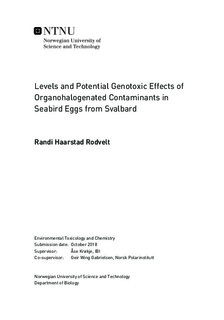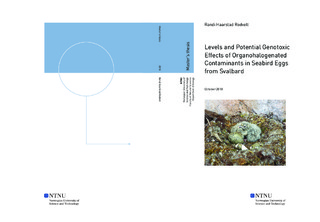| dc.description.abstract | Organohalogenated contaminants (OHCs) have been detected in relative high levels in arctic seabirds and eggs and are of great concern due to their potential toxic effects. OHCs are incorporated into the eggs during egg formation and the avian embryo get exposed when it absorbs these contaminants together with albumen and yolk during development. Critical developmental processes occur at the same time, which makes the embryo extra sensitive and vulnerable to toxic effects. Assessing levels and toxic effects in eggs during avian embryo development is therefore important.
The objective of the present study is to investigate the potential for OHC induced genotoxic effect in form of DNA double strand breaks (DNA DSB) in eggs from glaucous gull (Larus hyperboreus), kittiwake (Rissa tridactyla) and common eider (Somateria mollissima). 33 eggs from glaucous gull (n = 5), kittiwake (n = 11) and common eider (n = 17) were collected around the Ny-Ålesund archipelago. The blastodisc was analysed for DNA DSB by agarose gel electrophoresis where the migrated fraction of the total DNA (DNA-FTM) and median molecular length (MML) were quantified. Yolk and albumen were homogenized and analysed for 82 OHCs.
Eggs from glaucous gull had the highest OHCs levels (Ʃ48OHC 726.98 ng/g ww) followed by eggs from kittiwake (Ʃ50OHC 608.61 ng/g ww) and common eider (Ʃ34OHC 45.07 ng/g ww). The pattern was similar in the species and consistent with previous studies. There were no significant differences in DNA-FTM or MML levels in eggs from the three species. For kittiwake and common eider eggs, no relationship was observed between egg volume and lipid content with OHCs, except for lipid with polychlorinated biphenyls (PCBs) in kittiwake. However, developmental stage showed a positive relationship with organochlorine pesticides (OCPs) and PCBs in common eider eggs, but not in kittiwake. None of the biological variables showed a relationship with DNA-FTM or MML. Furthermore, a positive relationship was found between MML and OCPs and MML and Polybrominated diphenyl ethers (PBDEs) in kittiwake eggs. Hence, a negative association between OHCs and DNA DSB. A possible explanation could be low OHCs levels in the blastodisc and an upregulation of the antioxidant defence system and repair systems. However, the mechanisms behind this negative relationship are unclear and repair systems, antioxidant defence, apoptosis and OHC levels in the embryo early in development should be further investigated. | |

